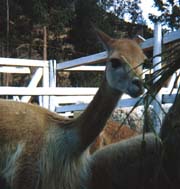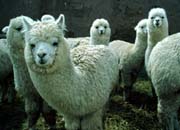|
The Andes, a Photo Gallery
 | | Photos link to larger images. |
|

Nevado Illimani, Bolivia's highest peak at 22,579 feet, towers almost two miles above this sheep pasture on the outskirts of La Paz. Three of the thirteen Andean peaks above 20,000 feet are in Bolivia. Bolivia's Cordillera Blanca stretches from Illimani northward to Illampu (20,873 feet above sea level), presenting one of the most impressive mountain chains in the world. (Old atlases have different data.) This view is from the plateau above metropolitan La Paz, near the airport. Long runways and special fuel and tires on jets are required here. Even from this elevation, near 13,000 feet, the mountains seem incredibly immense. |

Vicuñas are wild camelids and closely related to alpacas and llamas. They live at very high elevations. Their hair is exceedingly fine and in high demand. They were nearly hunted to extinction before being afforded legal protection. You might catch a glimpse of several from the Puno to Cuzco train, in the wild or at the La Raya experiment station, near the highest point along the route. These were at the Cuzco Fair.
Andes Placemarks |

Rich sunset colors drench a typical altiplano family compound, or wasi. This home is located above 14,000 feet in Azangaro province, Department of Puno, Perú. The temperature drops dramatically at sunset. At this altitude the growing season is too short for potatoes. The area is well suited to alpacas, llamas and vicuñas. |

Alpacas at a regional fair in Juliaca, Puno, Perú. Quality of fleece is an important consideration when judging these competitors. |

Another group of prize competitors at the Juliaca fair. Alpacas with white hair are the most valuable because their fleeces can be dyed. |

Potato harvest on a hillside north of Azangaro. This valley is above 13,000 feet. |

Potato harvest at Malquini, northeast of Azangaro. An ancient Incan trail traverses this canyon en route to the Amazon drainage across the Cordillera. The Malquini river disappears into gravel beds at the mouth of the canyon, trapping trout in deep pools. From the Inca road one can view into the clear pools and pick a challenge to angle for. trout fishing and the nearby hot springs made for a great break from our work routine. |

My good friend Cesár Paredes inspects a pile of freshly harvested potatoes. Local grasses are used to protect the piles of harvest from the sun and frosts. Cesár taught me a great deal about local agriculture and customs during our outings to visit prestamos, which he worked as the bank manager. If you know Cesár tell him to send me an e-mail. We lost contact years ago. |

The colonial church in Azangaro. In the Plaza San Bernardo to the left of the bell tower, Pedro Vilca Apaza was drawn and quartered for his role as a General in Tupac Amaru II's attempt to liberate Perú from the Spanish government. His last words were, "Por este Sol aprended a morir como yo." After Tupac Amaru II's execution, leadership of the revolution shifted to Azangaro.
The bell tower is an example of colonial decorative adobe, in this view much disfigured by rains. Recently, rains caused a collapse of most of the tower. The gold interior is a magnificent example of rich colonial art. Recently, colonial treasures were robbed from the so-called 'golden temple.'
Colonialism and Liberation | 
A street scene in Azangaro from the former office of the Ministerio de Agricultura office complex where I worked in 1969-70. The complex was also my home. In the background is the market building. Many vendors set up in the street every day, and once a week -- on market day -- the streets around the market filled with vendors. Every day several medicinal herb vendors were found at this corner, near my door. They gave me my first introduction to herbal properties and the numerous herbal remedies from the many ecological regions in the Andes.
A Brief Note Regarding Campa Medical Practices |

In this view the terraces are the remains of Pucará, a former center of Andean culture west of Azangaro and northwest of Lake Titicaca. Pucará was part of my work area. It is famous for excellent pottery, and has been a pottery center for several thousand years. This is also the site of liberator José Domingo Choquehuanca's famous speech and dicho, "Con los siglos crecerá nuestra gloria como crece la sombra cuando el Sol declina." |

An adobe building near the Tiwanaku ruins in Bolivia. There are so many pottery sherds in the area that the local adobe has numerous fragments visible in the walls. Walking the Tiahuanaco village streets is also a tour of ancient pottery embedded in all the walls. |

A group of agriculturists are gathering their harvest in the valley between Puno and Cuzco. It is typical to see groups of people working the fields in the Andes, where the ayllu custom of community organization and cooperation has persisted.
Idyllic scenes such as this are the fare of the day for train travelers between the cities. From Puno the train passes over barren 14,172 feet La Raya pass, past a research station with large herds of alpacas and some vicuñas. The transitions continue as the train descends towards Cuzco. This view is of an area low enough in elevation for many crops and trees. |

An ancient Incan masonry doorway on a Cuzco street. Original Incan masonry lines many Cuzco streets and can be seen in restaurants, homes and churches. In a recent earthquake plaster broke from some walls to reveal previously hidden Inca walls of the Coricancha inside the monastary of St. Augustine's church. |